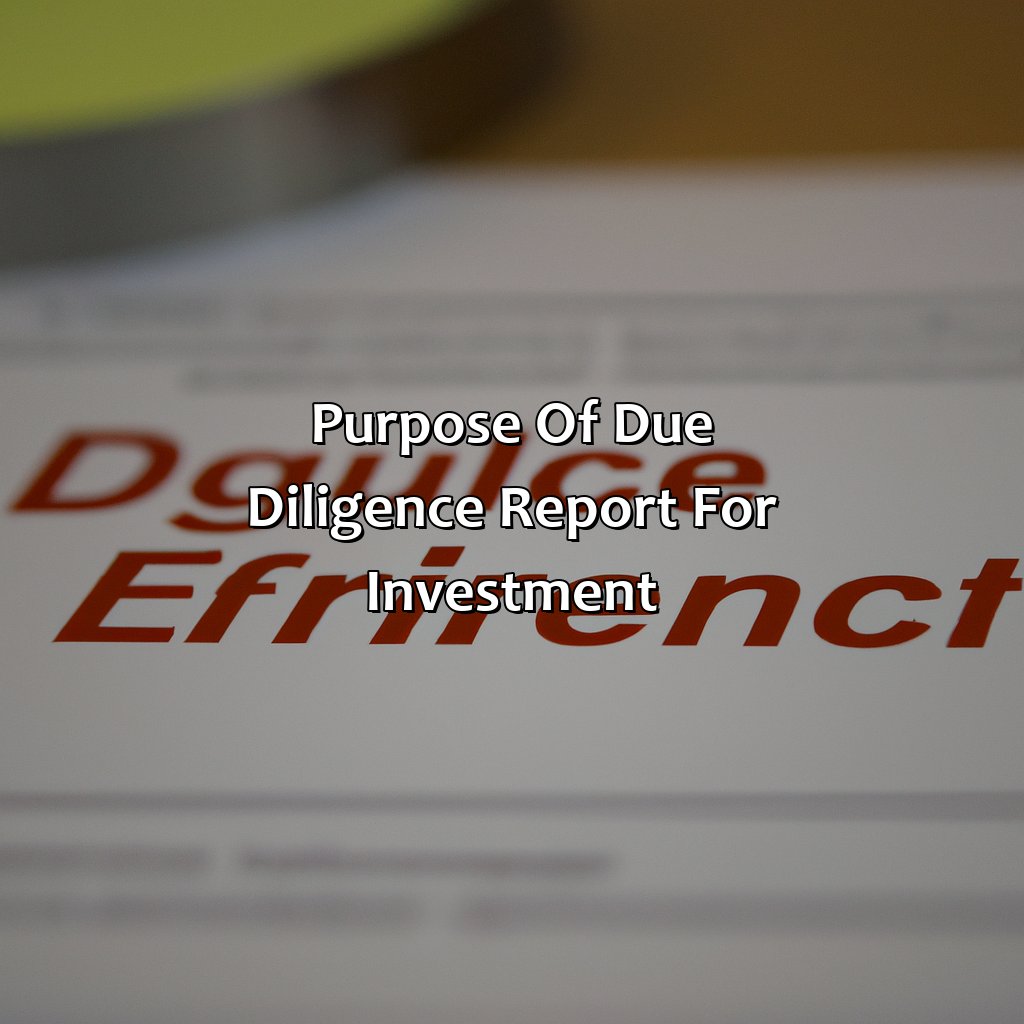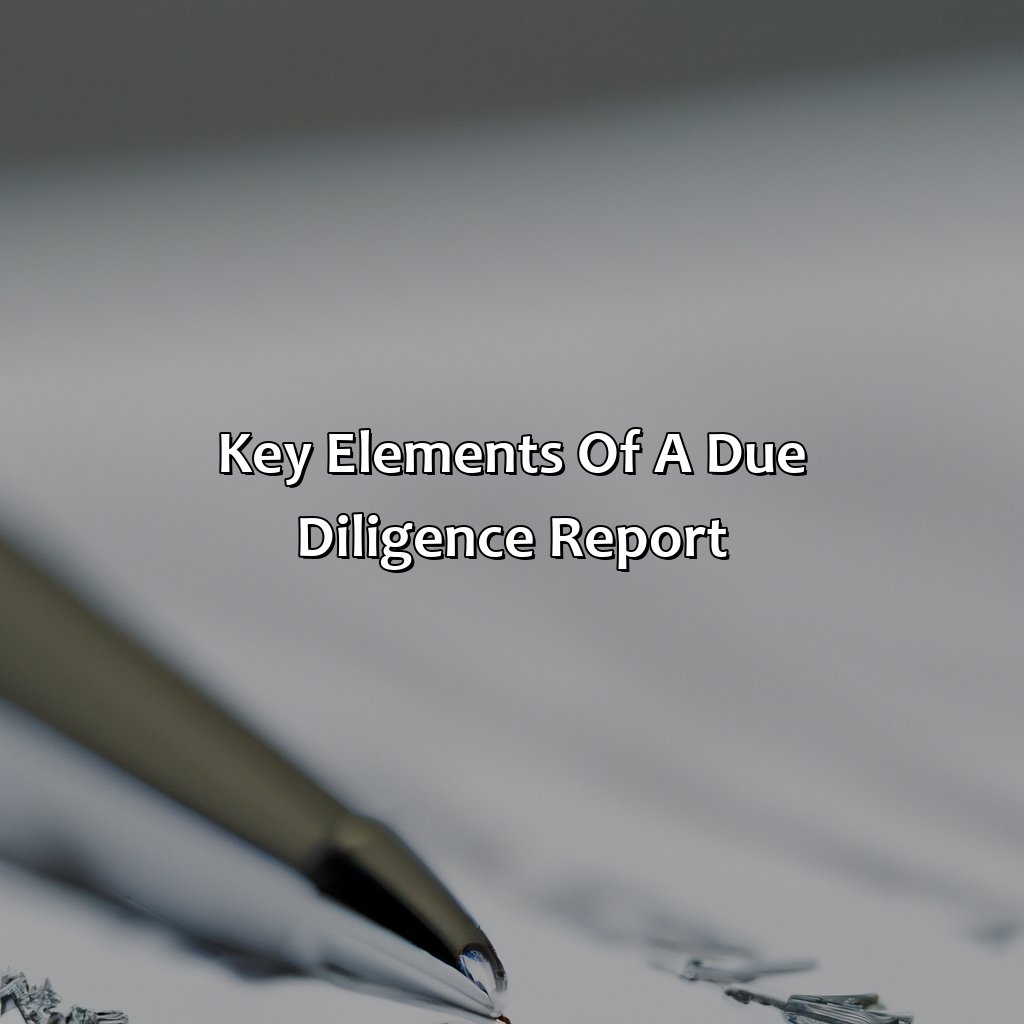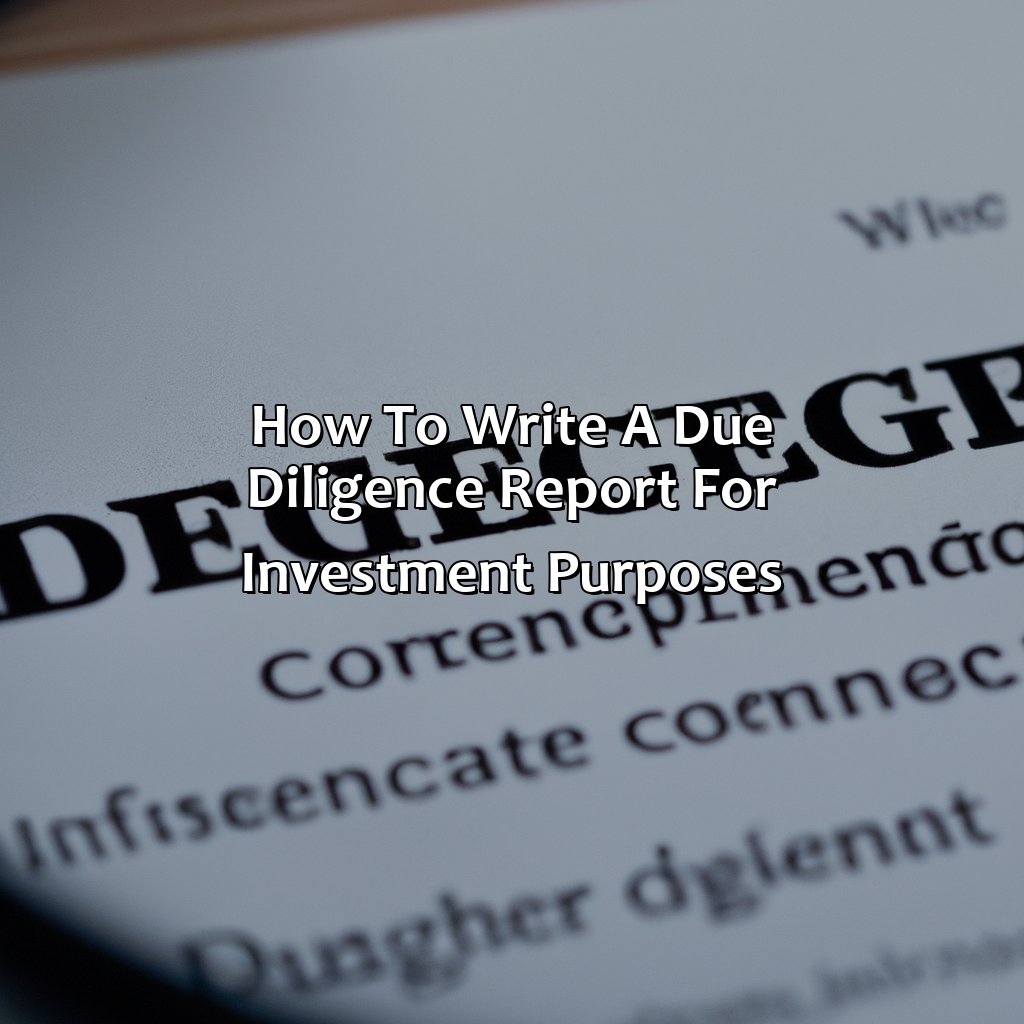How To Write A Due Diligence Report For Investment Purposes?
Key Takeaway:
- A Due Diligence Report is a comprehensive investigation of a potential investment opportunity to assess its risks and opportunities for potential investors.
- The purpose of a Due Diligence Report for Investment is to uncover any potential issues that may impact the investment, such as financial, legal, or market-related concerns, and provide valuable insights on the investment opportunity.
- A well-rounded Due Diligence Report should include essential elements like company information, financial information, legal information, market analysis, management team analysis, exit strategy analysis, and an assessment of risks and mitigation strategies.
Are you looking for tips to write an effective due diligence report for investment purposes? This blog will explain the key steps you need to follow to create a comprehensive report. Discover the benefits of conducting a thorough due diligence process and learn how to effectively communicate your findings.
Purpose of Due Diligence Report for Investment
Investment Due Diligence Report
Purpose: Starting with requirements for analyzing potential investments, and highlighting potential risks and opportunities, the due diligence report for investment serves as a comprehensive guide that helps investors make well-informed decisions.
This report provides extensive information regarding the target company, financials, business model, management team, competition, market position, and other key aspects. By presenting an overview of the investment opportunity, the report enables investors to assess the feasibility of investing in a particular opportunity.
Further, the report also helps investors to identify potential factors that may impact the investment decision and, therefore, helps them evaluate the suitability of the investment opportunity. This report is essential for investors since it not only helps in mitigating potential investment risks but also facilitates shortlisting of the right investment opportunities through comprehensive analysis.
In addition to this, the report also helps investors achieve a better understanding of the investment’s potential long-term value. As a result, this report acts as a critical tool in aiding decision-making processes that can have significant financial implications. With such a comprehensive report on hand, investors can make informed decisions, leading to increased confidence and reduced potential risks.

Image credits: retiregenz.com by Adam Washington
Key Elements of a Due Diligence Report
For investment purposes, compose a thorough due diligence report. The report should include the following primary aspects:
- Company analysis: Overview of the company’s history, mission, vision, values, and culture.
- Financial analysis: Detailed financial reports including income statements, balance sheets, cash flow statements, and financial ratios.
- Legal analysis: Review of all legal documents such as company structure, ownership, contracts, rights and obligations, disputes, and any potential liabilities or legal risks.
- Market analysis: Research and analysis of the company’s market, customers, competitors, and industry trends.
- Management team analysis: Overview of key management team members including experience, qualifications, skills, and track record.
- Exit strategy analysis: Review of options for exit, such as mergers and acquisitions or initial public offerings (IPOs).
Divide the report into subsections for a thorough overview. Ensure all essential information is included for a complete report.

Image credits: retiregenz.com by Yuval Washington
Company Information
Guidance on Information Required for Your Analysis
When conducting due diligence, the review of all Company Information is essential. Analyze financial statements, assess insurances & licenses, note any legal disputes, investigate potential intellectual property rights infringements and identify customer or supplier concentration. Review employee contracts in order to address labor issues and also analyze environmental compliance. Ensure access to relevant internal documents and maintain direct contact with key individuals in the company.
It is also important that you check for any red flags during your Company Information analysis. Scrutinize everything to assure that you have been given all the necessary information to make an informed decision about whether your potential acquisition target aligns with your goals.
By conducting a comprehensive review of all relevant information concerning a company as part of your due diligence process, you lessen your chances of being blindsided by negative surprises after investing. Failure to employ proper due diligence may lead you on several issues which can cause great loss.
Get ready to crunch some numbers and give your calculator a workout as we delve into the financial information section of the due diligence report.
Financial Information
The Financial Performance section of a Due Diligence Report provides a critical analysis of financial statements. The report includes information on the company’s balance sheet, income statement, cash flow statement, and financial ratios. Financial performance evaluation enables investors to evaluate risks adequately and make informed investment decisions.
In addition to reviewing financial statements, it is essential to analyze potential discrepancies in reporting practices, accounting policies, revenue recognition, and tax issues. Such investigations can help identify any ongoing or past legal or regulatory issues that may impact an investor’s decision.
A thorough Due Diligence Report will also feature extensive research into market trends and competitors’ financial metrics. Comparing the target company to its peers can provide valuable insights into industry-wide opportunities and challenges.
According to a recent study by MarshBerry & Company analyzing merger and acquisition activity in the insurance industry from 2010-2018, private equity buyers represented over 50% of all transactions in 2018.
Legal information might not be everyone’s cup of tea, but it’s definitely an essential ingredient in the due diligence recipe.
Legal Information
When compiling a due diligence report, it is essential to include comprehensive legal information. This information covers the legal framework surrounding the target investment and potential litigation risks. Legal due diligence empowers investors to make informed decisions and mitigate risks before investing.
The legal data included in a due diligence report typically cover ownership rights, permits, licenses, contracts, and litigation history. It is crucial to verify all ownership claims and ensure compliance with regulatory requirements in the target investment location. Additionally, reviewing existing contracts for clauses that could impact investment returns can also help identify potential risks accurately.
To get accurate legal information on a target investment, several sources should be evaluated simultaneously rather than relying on one source alone. The various sources may include government registration records, court filings, and the company’s contractual agreements.
Problems arise when critical legal data are overlooked or inadequately researched during due diligence evaluations. For example, failing to review litigation history adequately can result in financial liabilities for investors post-investment.
Investment opportunities are like poker games – you need to analyze the market before placing your bets.
Market Analysis
The evaluation of market dynamics includes analyzing industry trends, competition, customer needs, and demand. It also examines the regulatory environment, market size and growth potential, and target segments. Additionally, it assesses risks that could affect the business such as changing consumer preferences and technological disruption.
A thorough market analysis covers a range of data sources such as internal company reports, sector-specific reports, government statistics and industry associations. The gathered information is used to create a competitive framework and identify opportunities for growth.
It’s crucial to understand how macroeconomic factors could impact business performance. Economic indicators like inflation rates, interest rates and GDP growth rate should be factored into the analysis.
It’s important to note that due diligence must evidence its claimed findings. As stated by Renaissance Capital “As an investor looking at international IPOs you need to proceed with extra caution.” A trusted global news organization Forbes on 07/04/2021 published a report that China’s internet giants are being pulled back under the control of President Xi Jinping’s government.
Analyzing the management team is like playing detective, but instead of solving crimes, you’re investigating the potential success or failure of an investment.
Management Team Analysis
The Evaluation of the Executive Team
The executive team analysis is a critical component of any due diligence report. The evaluation of the management team seeks to assess their ability to execute the business strategy successfully. It examines various leadership aspects, including experience, industry knowledge, professionalism, etc.
Investors evaluate the past performances and success rates of executives using objective criteria such as revenue growth levels and market share gains.
It is necessary to understand how executives make strategic decisions for their business model’s portfolio. By analyzing team members’ education and their backgrounds in similar fields can give a sense of how dedicated they are towards achieving great results for their businesses.
Investors can gain an advantage by considering potential strategies and areas where management requires assistance while analyzing roles, responsibilities, and other components that help understand management capabilities.
To sum up, many aspects can be used to analyze an executive team comprehensively. This assessment strives to measure whether or not an experienced leader is responsible for overseeing execution, planning adequately while assessing risks involved in various aspects.
Remember, having an exit strategy is like having a backup parachute, you hope you never need it, but it’s better to have one just in case.
Exit Strategy Analysis
A comprehensive analysis on the strategies available for investors to exit an investment is essential. Understanding how to maximize the return on investment during the departure process is crucial. Factors such as market conditions, competition levels, and timing must be considered to ensure the optimization of profits during exit from a particular investment.
When analyzing potential exits, it is vital that investors have a clear overview of the various options available. These may include selling shares through private or public transactions, mergers and acquisitions, or recapitalization. Consequently, proper consideration should be given to each choice based on an evaluation of risks, costs and benefits.
To make informed decisions on exiting from investments requires a deep understanding of a company’s financial information over time. An investor must also determine when would be the most advantageous period to exit their investment by identifying key performance indicators such as profit margins and revenue growth.
An analysis towards an Exit Strategy allows aspiring investors in identifying information gaps and helps with evaluating businesses through key items like past data trends and competitor strategy deployments to ascertain future expectations accurately.
Be a detective, not a stalker: Tips for gathering information in a due diligence report.
Methods for Gathering Information
Gathering Information for Due Diligence Reports
Investment due diligence reports require a thorough and systematic investigation of the target company. Information gathering is crucial in assessing the target company’s financial, legal, and operational aspects. Techniques to gather information include reviewing financial statements, conducting online research, analysing regulatory filings, interviewing relevant personnel, and visiting key facilities.
One of the critical methods for gathering information is a careful review of the target company’s financial reports, including balance sheets, income statements, and cash flow statements, to understand the company’s financial standing and identify areas of concern. Online research can be conducted to determine the target company’s performance, industry trends, and the competitive landscape. Regulatory filings must be scrutinized to identify any legal risks, including potential liabilities, compliance issues, and regulatory constraints.
In addition to document reviews and online research, conducting interviews with key stakeholders, such as management, employees, and customers, is an essential component to gather information about the target company’s corporate culture, working conditions, customer experience, and potential growth opportunities. Site visits to the company’s key facilities can provide a realistic view of how the company operates and identify any issues that may not be evident from document reviews.
Understanding the importance of information gathering is reflected through history where a lack of due diligence resulted in disastrous outcomes. The 2008 financial crisis was in part due to the lack of proper due diligence, particularly in the collateralized debt obligation market. This history highlights the importance of meticulous information gathering during investment due diligence.

Image credits: retiregenz.com by Adam Woodhock
Analysis and Evaluation of Information
To conduct an effective analysis and evaluation of information for investment purposes, one must carefully examine and scrutinize all available data, considering its relevance, accuracy, and potential risks. This process involves conducting thorough research, analyzing financial statements, reviewing legal documents, and assessing the overall market environment. With a deep understanding of the information gathered, investors can make informed decisions and minimize potential risks.
It is crucial to assess the company’s financial standing, including revenue growth, profit margins, and cash flow generation. Additionally, understanding the company’s industry landscape, competitors, and market trends can provide critical insights into future growth potential. Conducting thorough due diligence on key executives and their history within the industry is also essential.
To ensure a comprehensive evaluation, investors should also conduct legal due diligence, assessing any potential legal liabilities that may arise from the investment. This includes reviewing contracts, financial statements, and relevant legal documents thoroughly. An understanding of regulatory requirements and compliance with applicable laws and regulations is also vital.
Pro Tip: Ensure due diligence is conducted with utmost confidentiality to prevent any data leaks.

Image credits: retiregenz.com by David Woodhock
Risks Assessment and Mitigation Strategies
Assessing Risks and Implementing Mitigation Strategies
To ensure sound investment decisions, it is crucial to identify and evaluate potential risks associated with the investment opportunity. In addition, it is equally necessary to develop effective mitigation strategies to minimize these risks.
Evaluating possible risks involves analyzing the investment opportunity from all angles, researching market trends and competitors, and assessing the financial stability of the investment. Once the risks are identified, mitigation strategies can be created to minimize or prevent these risks, which may involve restructuring the investment, diversifying the investment portfolio, or implementing contingency plans.
It is imperative to closely monitor the implementation of these mitigation strategies and mitigate any potential risks that may arise during the investment period. This requires a proactive approach in identifying potential issues and rectifying them promptly.
A successful example of implementing a risk assessment and mitigation strategy is the 2008 financial crisis, where banks had to improve their risk management policies and processes to avoid similar situations in the future.

Image credits: retiregenz.com by Harry Washington
5 Well-Known Facts About How To Write A Due Diligence Report For Investment Purposes:
- ✅ A due diligence report helps investors make informed decisions based on thorough analysis of a potential investment. (Source: Investopedia)
- ✅ The report should cover financial statements, industry trends, market analysis, and legal issues among other key areas. (Source: Forbes)
- ✅ The due diligence process should be done by qualified professionals with expertise in the relevant industry and legal matters. (Source: Entrepreneur)
- ✅ The report should be comprehensive, objective, and transparent, highlighting both the potential risks and benefits of the investment. (Source: Harvard Business Review)
- ✅ Due diligence should be an ongoing process, not just a one-time event, to ensure continued success and minimize potential risks. (Source: Deloitte)
FAQs about How To Write A Due Diligence Report For Investment Purposes?
What is a due diligence report for investment purposes?
A due diligence report for investment purposes is a document that provides comprehensive information about a business or investment opportunity. It helps investors make informed choices by outlining risks, opportunities, financial projections, and other essential details.
How do I start writing a due diligence report for investment purposes?
To start writing a due diligence report for investment purposes, gather as much information as possible about the business or investment opportunity. This may include reviewing financial statements, conducting site visits, speaking with key stakeholders, and assessing industry trends.
What should I include in a due diligence report for investment purposes?
A due diligence report for investment purposes should include information on the company’s financial health, management team, market position, competitive landscape, legal and regulatory issues, and potential risks and opportunities. It should also provide a detailed analysis of all the data collected during the due diligence process.
How do I organize a due diligence report for investment purposes?
To organize a due diligence report for investment purposes, you may consider dividing it into sections that cover the main topics outlined in the previous question. You may also create an executive summary at the beginning of the report to provide an overview of the key findings.
What are some common mistakes to avoid when writing a due diligence report for investment purposes?
Some common mistakes to avoid when writing a due diligence report for investment purposes include rushing through the process, relying on incomplete or inaccurate data, using jargon or technical language that may be difficult for investors to understand, and failing to identify and address potential risks.
What are some tools or resources I can use to write a due diligence report for investment purposes?
Some tools or resources you may use when writing a due diligence report for investment purposes include financial analysis tools, industry reports, databases of comparable companies, legal and regulatory resources, and templates or examples of due diligence reports.


